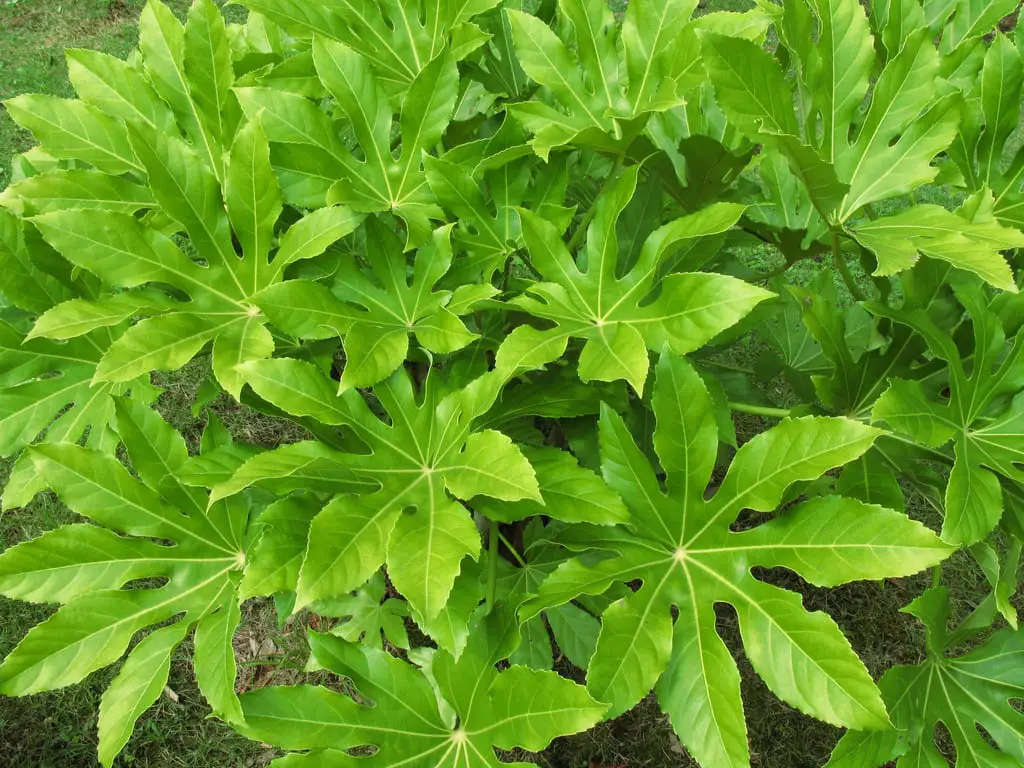
Image – Flickr / TANAKA Juuyoh
The aralia plant It is one of the most popular in warm gardens and, above all, indoors. It has very pretty bright green webbed leaves, and a fairly rapid growth rate; Although this does not have to worry us, since it reaches a height of only one meter if it is in a pot, and no more than four if it is grown in soil.
It is a plant very decorativewith which the home will undoubtedly look more full of life.
Characteristics of aralia
The aralia, whose scientific name is Fatsia japonica, it is an evergreen shrubby plant native and endemic to Japan that reaches a height of up to 5 meters. It is characterized by having large leaves of 30 to 50 centimeters, webbed and thick, of a bright green color.
The flowers are grouped in umbel-shaped inflorescences, white or cream-colored, and are hermaphroditic. The fruits are globose drupes, glossy black when ripe, containing somewhat compressed seeds.
It is a plant that lives under the protection of other plantsso the sun never hits it directly. But let’s look at it in more detail.
How do you take care of yourself?

If you want to have one or more specimens, here is your care guide:
Location
The aralia plant will grow much better outdoors in semi-shade than indoors. However, due to its origin, it is very sensitive to cold, so during the winter it is advisable to keep it in a room where a lot of light enters, but placed away from the windows.
Soil or substrate
- the garden: it must have good drainage, be light and rich in organic matter. Their roots are very sensitive to overwatering, so if the soil is not able to drain the water quickly, they will rot.
- Flower pot: you must mix universal culture substrate mixed with perlite in equal parts.
Irrigation

Image – Wikimedia Commons / Orengi Harvey
The frequency of irrigation will be moderate; In other words, you don’t have to water a lot but not a little either. Ideally, depending on the climate, water an average of two or three times a week in summer, and every five or six days the rest of the year.
If you have it in a pot, it is preferable that you do not put any plate under it as the stagnant water will damage the roots unless it is removed after a while – about 20 minutes – of having watered.
Use rainwater as much as possible, but if you can’t get it, use water without lime or suitable for human consumption. Water until you see that the soil or substrate is very moist; in this way, the plant will stay properly hydrated.
Subscriber
From early spring to late summer it is important to fertilize it with a liquid fertilizer if it is in a pot, such as guano, following the indications specified on the package, or with one in powder or granules such as manure from herbivorous animals for example.
Planting or transplanting time
Whether you want to plant your aralia in the garden or move it to a somewhat larger pot, you have to do it in spring When the minimum temperature exceeds 15 degrees Celsius.
Multiplication

It multiplies by seeds in spring and by cuttings in summer:
Seeds
The seeds must be placed in a glass with water for 24 hours before sowing them in a seedbed with a specific substrate (for sale here!) or universal mixed with 30% of perlite.
It is important that they are positioned so that they are as far apart from each other as possiblein order to guarantee the survival of a greater number of -future- seedlings.
They are buried a little, and it is watered to later place the seedbed outside, in semi-shade.
In about 1 month they will germinate.
Cuttings
Cuttings are taken in summer, from branches. The base is impregnated with homemade rooting agents and planted in a pot with vermiculite (for sale here!) previously moistened with water. Finally, wrap everything with plastic that you will have previously made some small holes with, for example, the tip of a pair of scissors or a knife.
In about 20 days they will root.
To avoid the appearance of fungi, it is advisable to sprinkle copper or sulfur on the surface of the substrate, or if you prefer to spray with a fungicide spray.
Pests
It is quite resistant, but can be attacked aphids, spider mites and mealybugs. Since the plant is relatively small, you can remove the insects by cleaning it with mild soap and water.
Common problems
There are a number of growing problems that are quite common. Let’s see how to fix them:
- Black leaves: it is usually because it has frozen. The damaged parts must be removed and protected from the cold.
- Burned leaves: excess of sun. You have to take it to a more sheltered place.
- Stem with few leaves: lack of ventilation (beware: do not place it in a very windy area or near drafts from windows, doors or air conditioners as it would not support it).
- Yellow sheets: if the yellowing begins with the oldest leaves, it is usually due to overwatering; On the other hand, if you start with the newest ones, it is due to lack of irrigation. In these cases, watering must be reduced or increased as necessary.
Rusticity
It is sensitive to frost. If the temperature drops below 0ºC you will need protection.

Image – Wikimedia / Krzysztof Ziarnek, Kenraiz // Fatsia japonica f. variegated
What did you think of this plant?

